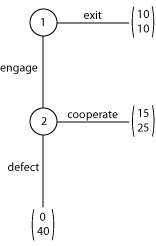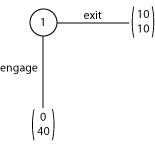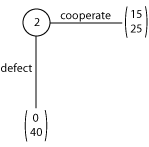|
|
| ||
Trust Game Experiment
Two different approaches can be used in experiments with the Trust Game. A simple experiment involving only the Trust Game (which is Treatment 1 below) will reveal deviations from the economic man model that are consistent with trust and positive reciprocity. A more complicated experiment involving the Trust Game and two dictator control games (Treatments 2 and 3 below) discriminates between trust and altruism and between positive reciprocity and altruism.
Treatments
Treatment 1. Trust Game
The two players’ payoffs are given by (f, s), where the left number f is the first mover’s payoff and the right number s is the second mover’s payoff. The first mover can choose between Exit and Engage. If the first mover chooses Exit then the game ends, without the second mover making a decision, and the payoffs are (10, 10). If the first mover chooses Engage then the second mover has a choice between Defect, with payoffs (0, 40), and Cooperate, with payoffs (15, 25). (In the game tree below and in the game tree in the EFG software for this game, the first mover’s payoff f is the top number and the second mover’s payoff s is the bottom number.)

Here is a configuration file for an experiment with this Trust Game only.
The more elaborate design that discriminates between trust and altruism and between positive reciprocity and altruism can be implemented with an experiment that includes Treatment 1 (above) and Treatments 2 and 3 (described below). Here is a configuration file for Treatments 1, 2, and 3.
Treatment 2. First Mover Dictator Control for the Trust Game
The two players’ payoffs are given by (d, n), where the left number d is the dictator’s (“first mover’s) payoff and the right number n is the non-mover’s payoff. (In the game tree below and in the game tree in the EFG software, the dictator’s payoff d is the top number and the non-mover’s payoff n is the bottom number.) The dictator can choose between “Exit,” with payoffs (10, 10), and “Engage,” with payoffs (0, 40).

Treatment 3. Second Mover Dictator Control for the Trust Game
The two players’ payoffs are given by (n, d), where the left number n is the non-mover’s payoff and the right number d is the dictator’s (“second mover’s”) payoff. The dictator can choose between “Defect,” with payoffs (0, 40) and “Cooperate,” with payoffs (15, 25). (In the game tree below and in the game tree in the EFG software for this game, the non-mover’s payoff n is the top number and the dictator’s payoff dis the bottom number.)

Discussion
- First movers in the Trust Game will split into somewhat unequal size groups of those who choose Exit and those who choose Engage.
- The majority of second movers in the Trust Game who get to move will choose (0, 40) but many will choose (15, 25).
- Almost all dictators in the first mover dictator control for the Trust Game will choose (10, 10).
- Dictators in the second mover dictator control for the Trust Game will split into unequal size groups who choose (0, 40) and (15, 25).
Treatment 1 data:
- The homo economicus model predicts: (a) any second movers who get a chance to move (because some first movers choose Engage) will choose Defect, with payoffs (0, 40), because they only care about their own material payoffs (and hence prefer 40 to 25); and (b) knowing that second movers only care about their own payoffs, all first movers will choose Exit because they also only care about their own payoffs (and hence prefer 10 to 0). With all first movers choosing Exit, each pair of first and second movers receive payoffs (10, 10). This (subgame perfect) equilibrium of the Trust Game for homo economicus is inefficient because it is Pareto inferior to the feasible payoffs (15, 25).
- Straightforward display of the data reveals actual play of the game by the participants.
Treatments 1 and 2 data:
- A natural interpretation of the choice made by a first mover who chooses Engage is that the first mover is exhibiting trust that the second mover will not make the first mover worse off by defecting. But how do we know that the first mover can be made worse off? If none of the second mover’s available choices could make the first mover worse off (because he/she is very altruistic) then no trust need be involved in choosing Engage. Together, Treatments 1 and 2 permit us to address this question. If someone chooses Engage in Treatment 1 (the Trust Game) and Exit in Treatment 2 (the dictator game) then we can conclude that in Treatment 1 he/she exhibited trust (that the second mover would not choose the outcome (0, 40) that has been revealed to be dispreferred to (10, 10) in the dictator game).
- Straightforward display of the data for both treatments shows how many participants are known to have exhibited trust.
Treatments 1 and 3 data:
- A natural interpretation of the choice made by a second mover who chooses Cooperate is that the second mover is exhibiting positive reciprocity by not defecting. But how do we know that the second mover prefers (0, 40) to (15, 25)? If the second mover has altruistic preferences such that (15, 25) is preferred to (0, 40) then the choice of Cooperate in the Trust Game does not reveal positive reciprocity. Together, Treatments 1 and 3 permit us to address this question. If someone chooses Cooperate in Treatment 1 (the Trust Game) and Defect in Treatment 2 (the dictator game) then we can conclude that in Treatment 1 he/she exhibited positive reciprocity (he/she chose the outcome that would be dispreferred in the absence of a social norm for positive reciprocity).
- Straightforward display of the data for both treatments shows how many participants are known to have exhibited positive reciprocity.
- First movers in the Trust Game will split into somewhat unequal size groups of those who choose Exit and those who choose Engage.
- Between 75% and 90% of the dictators in the first mover dictator control for the Trust Game will choose “Exit.”
- Between 5% and 20% of the dictators in the second mover dictator control for the Trust Game will choose “Cooperate.”
| Copyright 2006 Experimental Economics Center. All rights reserved. | Send us feedback |



